COVID-19, Livestock Systems and Food Security in Developing Countries: A Systematic Review of an Emerging Literature
Abstract
1. Introduction
2. Systematic Literature Review Approach
2.1. Search Codes
2.2. Search Strategy
2.3. Inclusion Criteria and Quality Control Procedures
2.4. Article Coding and Data Extraction
3. Results and Synthesis of Evidence
3.1. Descriptive Analysis of the Reviewed Articles
3.1.1. Publication Characteristics
3.1.2. Geographical and Spatial Distribution of Studies
3.1.3. Disciplinary Distribution and publication Outlets
3.1.4. Methodological Approaches and Investigated Livestock Systems
3.2. Thematic and Content-Based Analysis of the Reviewed Articles
3.2.1. Effects of the Pandemic on Livestock Supply Chains
3.2.2. Effects of the Pandemic on the Resilience of the Livestock Systems
3.2.3. Interlinkages between Covid-19 Impact of Livestock Systems and Food Security
4. Discussion and Implications for Future Research
Supplementary Materials
Author Contributions
Funding
Institutional Review Board Statement
Informed Consent Statement
Data Availability Statement
Acknowledgments
Conflicts of Interest
References
- Hashem, N.M.; González-Bulnes, A.; Rodriguez-Morales, A.J. Animal Welfare and Livestock Supply Chain Sustainability Under the COVID-19 Outbreak: An Overview. Front. Vet. Sci. 2020, 7, 1–11. [Google Scholar] [CrossRef] [PubMed]
- FAO. Impact of COVID-19 on Agriculture, Food Systems and Rural Livelihoods in Eastern Africa: Policy and Programmatic Options; FAO: Rome, Italy, 2020. [Google Scholar]
- OECD. COVID-19 and the Food and Agriculture Sector: Issues and Policy Responses; OECD: Paris, France, 2020; p. 12. [Google Scholar] [CrossRef]
- Hafez, H.M.; Attia, Y.A. Challenges to the Poultry Industry: Current Perspectives and Strategic Future After the COVID-19 Outbreak. Front. Vet. Sci. 2020, 7, 516. [Google Scholar] [CrossRef] [PubMed]
- Abu Hatab, A.; Cavinato, M.E.R.; Lagerkvist, C.J. Urbanization, livestock systems and food security in developing countries: A systematic review of the literature. Food Secur. 2019, 11, 279–299. [Google Scholar] [CrossRef]
- Dror, D.K.; Allen, L.H. The importance of milk and other animal-source foods for children in low-income countries. Food Nutr. Bull. 2011, 32. [Google Scholar] [CrossRef]
- Godfray, H.C.J.; Aveyard, P.; Garnett, T.; Hall, J.W.; Key, T.J.; Lorimer, J.; Pierrehumbert, R.T.; Scarborough, P.; Springmann, M.; Jebb, S.A. Meat consumption, health, and the environment. Science 2018, 361. [Google Scholar] [CrossRef]
- Enahoro, D.; Herrero, M.; Johnson, N. Promising options for improving livestock production and productivity in developing countries. In ILRI Project Report; ILRI: Nairobi, Kenya, 2019; p. 36. [Google Scholar]
- Otte, M.J.; Nugent, R.; McLeod, A. Transboundary Animal Diseases: Assessment of Socio-Economic Impacts and Institutional Responses; FAO: Rome, Italy, 2004; p. 46. [Google Scholar]
- Herrero, M.; Thornton, P.K. Livestock and global change: Emerging issues for sustainable food systems. Proc. Natl. Acad. Sci. USA 2013, 110, 20878–20881. [Google Scholar] [CrossRef]
- FAO. Mitigating the Impacts of COVID-19 on the Livestock Sector; FAO: Rome, Italy, 2020; p. 6. [Google Scholar] [CrossRef]
- Fitzpatrick, J.L. Global food security: The impact of veterinary parasites and parasitologists. Vet. Parasitol. 2013, 195, 233–248. [Google Scholar] [CrossRef]
- McElwain, T.F.; Thumbi, S.M. Animal pathogens and their impact on animal health, the economy, food security, food safety and public health. Rev. Sci. Tech. 2017, 36, 423–433. [Google Scholar] [CrossRef]
- Dhama, K.; Patel, S.K.; Sharun, K.; Pathak, M.; Tiwari, R.; Yatoo, M.I.; Malik, Y.S.; Sah, R.; Rabaan, A.A.; Panwar, P.K.; et al. SARS-CoV-2 jumping the species barrier: Zoonotic lessons from SARS, MERS and recent advances to combat this pandemic virus. Travel Med. Infect. Dis. 2020, 37, 101830. [Google Scholar] [CrossRef]
- Mphande, F.A. Infectious Diseases and Rural Livelihood in Developing Countries, 1st ed.; Springer: Singapore, 2016; p. 193. [Google Scholar]
- Jemberu, W.T.; Mourits, M.C.M.; Woldehanna, T.; Hogeveen, H. Economic impact of foot and mouth disease outbreaks on smallholder farmers in Ethiopia. Prev. Vet. Med. 2014, 116, 26–36. [Google Scholar] [CrossRef]
- Pavade, G.; Awada, L.; Hamilton, K.; Swayne, D.E. The influence of economic indicators, poultry density and the performance of veterinary services on the control of high-pathogenicity avian influenza in poultry. Rev. Sci. Tech. 2011, 30, 661–671. [Google Scholar] [CrossRef]
- Hagerman, A.D.; Mathews, K.H.; McCarl, B.A. Economic dimensions and directions of animal disease policy. Int. J. Risk Assess. Manag. 2012, 16, 248–264. [Google Scholar] [CrossRef]
- Bobrowski, T.; Melo-Filho, C.C.; Korn, D.; Alves, V.M.; Popov, K.I.; Auerbach, S.; Schmitt, C.; Moorman, N.J.; Muratov, E.N.; Tropsha, A. Learning from history: Do not flatten the curve of antiviral research! Drug Discov. Today 2020, 25, 1604–1613. [Google Scholar] [CrossRef]
- McKee, M.; Stuckler, D. If the world fails to protect the economy, COVID-19 will damage health not just now but also in the future. Nat. Med. 2020, 26, 640–642. [Google Scholar] [CrossRef]
- Kabir, M.T.; Uddin, M.S.; Hossain, M.F.; Abdulhakim, J.A.; Alam, M.A.; Ashraf, G.M.; Bungau, S.G.; Bin-Jumah, M.N.; Abdel-Daim, M.M.; Aleya, L. nCOVID-19 Pandemic: From Molecular Pathogenesis to Potential Investigational Therapeutics. Front. Cell Dev. Biol. 2020, 8, 616. [Google Scholar] [CrossRef]
- Seleiman, M.F.; Selim, S.; Alhammad, B.A.; Alharbi, B.M.; Cezar Juliatti, F. Will novel coronavirus (Covid-19) pandemic impact agriculture, food security and animal sectors? Biosci. J. 2020, 36, 1315–1326. [Google Scholar] [CrossRef]
- Morton, J. On the susceptibility and vulnerability of agricultural value chains to COVID-19. World Dev. 2020, 136, 1–4. [Google Scholar] [CrossRef]
- Hussain, S.; Hussain, A.; Ho, J.; Sparagano, O.A.E.; Zia, U.-U.-R. Economic and Social Impacts of COVID-19 on Animal Welfare and Dairy Husbandry in Central Punjab, Pakistan. Front. Vet. Sci. 2020, 7, 1–5. [Google Scholar] [CrossRef]
- Grace, D.; Mutua, F.; Ochungo, P.; Kruska, R.; Jones, K.; Brierley, L.; Lapar, L.; Said, M.; Herrero, M.; Phuc, P.M.; et al. Mapping of poverty and likely zoonoses hotspots. In Report to the UK Department for International Development; ILRI: Nairobi, Kenya, 2012. [Google Scholar]
- Abu Hatab, A.; Cavinato, M.E.R.; Lindemer, A.; Lagerkvist, C.-J. Urban sprawl, food security and agricultural systems in developing countries: A systematic review of the literature. Cities 2019, 94, 129–142. [Google Scholar] [CrossRef]
- FAO. Food Security; FAO: Rome, Italy, 2006. [Google Scholar]
- Moher, D.; Liberati, A.; Tetzlaff, J.; Altman, D.G.; Group, P. Preferred reporting items for systematic reviews and meta-analyses: The PRISMA statement. PLoS Med. 2009, 6, e1000097. [Google Scholar] [CrossRef]
- Falagas, M.E.; Pitsouni, E.I.; Malietzis, G.A.; Pappas, G. Comparison of PubMed, Scopus, Web of Science, and Google Scholar: Strengths and weaknesses. FASEB J. 2008, 22, 338–342. [Google Scholar] [CrossRef] [PubMed]
- Paniagua, Á. Perspectives of Livestock Farmers in an Urbanized Environment. Land 2014, 3, 19–33. [Google Scholar] [CrossRef]
- Wong, J.T.; de Bruyn, J.; Bagnol, B.; Grieve, H.; Li, M.; Pym, R.; Alders, R.G. Small-scale poultry and food security in resource-poor settings: A review. Glob. Food Secur. Agric. Policy Econ. Environ. 2017, 15, 43–52. [Google Scholar] [CrossRef]
- Simula, G.; Bum, T.; Farinella, D.; Maru, N.; Mohamed, T.S.; Taye, M.; Tsering, P. COVID-19 and pastoralism: Reflections from three continents. J. Peasant Stud. 2020, 1–25. [Google Scholar] [CrossRef]
- Mottaleb, K.A.; Mainuddin, M.; Sonobe, T. COVID-19 induced economic loss and ensuring food security for vulnerable groups: Policy implications from Bangladesh. PLoS ONE 2020, 15, e0240709. [Google Scholar] [CrossRef] [PubMed]
- HLPE. Impacts of COVID-19 on food security and nutrition: Developing effective policy responses to address the hunger and malnutrition pandemic. Policy Brief 2020, 24. [Google Scholar] [CrossRef]
- Mishra, A.; Bruno, E.; Zilberman, D. Compound natural and human disasters: Managing drought and COVID-19 to sustain global agriculture and food sectors. Sci. Total Environ. 2021, 754, 1–6. [Google Scholar] [CrossRef] [PubMed]
- Pu, M.; Zhong, Y. Rising concerns over agricultural production as COVID-19 spreads: Lessons from China. Glob. Food Secur. 2020, 26, 1–7. [Google Scholar] [CrossRef] [PubMed]
- Bogdanova, E.; Andronov, S.; Morell, I.A.; Hossain, K.; Raheem, D.; Filant, P.; Lobanov, A. Food Sovereignty of the Indigenous Peoples in the Arctic Zone of Western Siberia: Response to COVID-19 Pandemic. Int. J. Environ. Res. Public Health 2020, 17, 7570. [Google Scholar] [CrossRef] [PubMed]
- Hossain, S.T. Impacts of COVID-19 on the Agri-food Sector: Food Security Policies of Asian Productivity Organization Members. J. Agric. Sci. Sri Lanka 2020, 15, 116–132. [Google Scholar] [CrossRef]
- Quayson, M.; Bai, C.; Osei, V. Digital Inclusion for Resilient Post-COVID-19 Supply Chains: Smallholder Farmer Perspectives. IEEE Eng. Manag. Rev. 2020, 48, 104–110. [Google Scholar] [CrossRef]
- Ejeromedoghene, O.; Tesi, J.N.; Uyanga, V.A.; Adebayo, A.O.; Nwosisi, M.C.; Tesi, G.O.; Akinyeye, R.O. Food security and safety concerns in animal production and public health issues in Africa: A perspective of COVID-19 pandemic era. Ethics Med. Public Health 2020, 15, 100600. [Google Scholar] [CrossRef]
- Swinnen, J.; McDermott, J. Covid-19 and Global Food Security. EuroChoices 2020, 19, 26–33. [Google Scholar] [CrossRef]
- Fan, S.; Si, W.; Zhang, Y. How to prevent a global food and nutrition security crisis under COVID-19? China Agric. Econ. Rev. 2020, 12, 471–480. [Google Scholar] [CrossRef]
- Joseph Fernando, A. How Africa Is Promoting Agricultural Innovations and Technologies amidst the COVID-19 Pandemic. Mol. Plant 2020, 13, 1345–1346. [Google Scholar] [CrossRef]
- Health, T.L.G. Food insecurity will be the sting in the tail of COVID-19. Lancet Glob. Health 2020, 8, 737. [Google Scholar] [CrossRef]
- USDA. Burma-Impact of COVID-19 on the Livestock Industry; USDA: Washington, DC, USA, 2020; p. 4. [Google Scholar]
- Ibn-Mohammed, T.; Mustapha, K.B.; Godsell, J.; Adamu, Z.; Babatunde, K.A.; Akintade, D.D.; Acquaye, A.; Fujii, H.; Ndiaye, M.M.; Yamoah, F.A.; et al. A critical analysis of the impacts of COVID-19 on the global economy and ecosystems and opportunities for circular economy strategies. Resour. Conserv. Recycl. 2021, 164, 1–22. [Google Scholar] [CrossRef]
- Hobbs, J.E. Food supply chains during the COVID-19 pandemic. Can. J. Agric. Econ./Rev. Can. D’agroeconomie 2020, 68, 171–176. [Google Scholar] [CrossRef]
- Galanakis, C.M. The Food Systems in the Era of the Coronavirus (COVID-19) Pandemic Crisis. Foods 2020, 9, 523. [Google Scholar] [CrossRef]
- Amjath-Babu, T.S.; Krupnik, T.J.; Thilsted, S.H.; McDonald, A.J. Key indicators for monitoring food system disruptions caused by the COVID-19 pandemic: Insights from Bangladesh towards effective response. Food Secur. 2020, 1–8. [Google Scholar] [CrossRef]
- Biswal, J.; Vijayalakshmy, K.; Rahman, H. Impact of COVID-19 and associated lockdown on livestock and poultry sectors in India. Vet. World 2020, 13, 1928–1933. [Google Scholar] [CrossRef]
- Gregorio, G.; Ancog, R. Assessing the Impact of the COVID-19 Pandemic on Agricultural Production in Southeast Asia: Toward Transformative Change in Agricultural Food System. Asian J. Agric. Dev. 2020, 17, 1–14. [Google Scholar] [CrossRef]
- Farrell, P.; Thow, A.M.; Wate, J.T.; Nonga, N.; Vatucawaqa, P.; Brewer, T.; Sharp, M.K.; Farmery, A.; Trevena, H.; Reeve, E.; et al. COVID-19 and Pacific food system resilience: Opportunities to build a robust response. Food Secur. 2020, 1–9. [Google Scholar] [CrossRef]
- Ma, N.L.; Peng, W.; Soon, C.F.; Noor Hassim, M.F.; Misbah, S.; Rahmat, Z.; Yong, W.T.L.; Sonne, C. Covid-19 pandemic in the lens of food safety and security. Environ. Res. 2020, 1–9. [Google Scholar] [CrossRef]
- Marchant-Forde, J.N.; Boyle, L.A. COVID-19 Effects on Livestock Production: A One Welfare Issue. Front. Vet. Sci. 2020, 7. [Google Scholar] [CrossRef]
- Cutter, S.L.; Ahearn, J.A.; Amadei, B.; Crawford, P.; Eide, E.A.; Galloway, G.E.; Goodchild, M.F.; Kunreuther, H.C.; Li-Vollmer, M.; Schoch-Spana, M.; et al. Disaster Resilience: A National Imperative. Environ. Sci. Policy Sustain. Dev. 2013, 55, 25–29. [Google Scholar] [CrossRef]
- Bene, C. Resilience of local food systems and links to food security—A review of some important concepts in the context of COVID-19 and other shocks. Food Secur. 2020, 12, 805–822. [Google Scholar] [CrossRef]
- Gwaka, L.; Dubihlela, J. The Resilience of Smallholder Livestock Farmers in Sub-Saharan Africa and the Risks Imbedded in Rural Livestock Systems. Agriculture 2020, 10, 270. [Google Scholar] [CrossRef]
- Griffith, E.F.; Pius, L.; Manzano, P.; Jost, C.C. COVID-19 in pastoral contexts in the greater Horn of Africa: Implications and recommendations. Pastor. Res. Policy Pract. 2020, 10, 22. [Google Scholar] [CrossRef]
- Pan, D.; Yang, J.; Zhou, G.; Kong, F. The influence of COVID-19 on agricultural economy and emergency mitigation measures in China: A text mining analysis. PLoS ONE 2020, 15, e0241167. [Google Scholar] [CrossRef]
- Jacob, M.C.M.; Feitosa, I.S.; Albuquerque, U.P. Animal-based food systems are unsafe: Severe acute respiratory syndrome coronavirus 2 (SARS-CoV-2) fosters the debate on meat consumption. Public Health Nutr. 2020, 23, 3250–3255. [Google Scholar] [CrossRef] [PubMed]
- Kanter, R.; Boza, S. Strengthening Local Food Systems in Times of Concomitant Global Crises: Reflections From Chile. Am. J. Public Health 2020, 110, 971–973. [Google Scholar] [CrossRef] [PubMed]
- Linkov, I.; Trump, B.D. The Science and Practice of Resilience; Springer: Berlin/Heidelberg, Germany, 2019. [Google Scholar]
- Christiaensen, L.; Rutledge, Z.; Taylor, J.E. Viewpoint: The future of work in agri-food. Food Policy 2020, 101963. [Google Scholar] [CrossRef] [PubMed]
- Zimmerer, K.S.; Haan, S.d. Informal food chains and agrobiodiversity need strengthening-not weakening-to address food security amidst the COVID-19 crisis in South America. Food Secur. 2020, 1–4. [Google Scholar] [CrossRef]
- Kumar, A.; Padhee, A.K.; Kumar, S. How Indian agriculture should change after COVID-19. Food Secur. 2020, 1–4. [Google Scholar] [CrossRef]
- Heck, S.; Campos, H.; Barker, I.; Okello, J.J.; Baral, A.; Boy, E.; Brown, L.; Birol, E. Resilient agri-food systems for nutrition amidst COVID-19: Evidence and lessons from food-based approaches to overcome micronutrient deficiency and rebuild livelihoods after crises. Food Secur. 2020, 12, 823–830. [Google Scholar] [CrossRef]
- Zidouemba, P.R.; Kinda, S.R.; Ouedraogo, I.M. Could Covid-19 Worsen Food Insecurity in Burkina Faso? Eur. J. Dev. Res. 2020, 1–23. [Google Scholar] [CrossRef]
- Aronson, D. Unite Human, Animal and Environmental Health to Prevent the Next Pandemic, Says ILRI/UN Report. Available online: https://www.ilri.org/news/unite-human-animal-and-environmental-health-prevent-next-pandemic-says-ilri-un-report (accessed on 26 February 2021).
- MacMillan, S. Joint UN-CGIAR Assessment Explains How Animal-to-Human Pandemics Like COVID-19 Occur and How to Prevent Them in Future. Available online: https://www.ilri.org/news/joint-un-cgiar-assessment-explains-how-animal-human-pandemics-covid-19-occur-and-how-prevent (accessed on 26 February 2021).
- Kansiime, M.K.; Tambo, J.A.; Mugambi, I.; Bundi, M.; Kara, A.; Owuor, C. COVID-19 implications on household income and food security in Kenya and Uganda: Findings from a rapid assessment. World Dev. 2021, 137, 1–10. [Google Scholar] [CrossRef]
- Paganini, N.; Adinata, K.; Buthelezi, N.; Harris, D.; Lemke, S.; Luis, A.; Koppelin, J.; Karriem, A.; Ncube, F.; Nervi Aguirre, E.; et al. Growing and Eating Food during the COVID-19 Pandemic: Farmers’ Perspectives on Local Food System Resilience to Shocks in Southern Africa and Indonesia. Sustainability 2020, 12, 8556. [Google Scholar] [CrossRef]
- Glover, R.E.; van Schalkwyk, M.C.I.; Akl, E.A.; Kristjannson, E.; Lotfi, T.; Petkovic, J.; Petticrew, M.P.; Pottie, K.; Tugwell, P.; Welch, V. A framework for identifying and mitigating the equity harms of COVID-19 policy interventions. J. Clin. Epidemiol. 2020, 128, 35–48. [Google Scholar] [CrossRef]
- Laborde, D.; Martin, W.; Swinnen, J.; Vos, R. COVID-19 risks to global food security. Science 2020, 369, 500–502. [Google Scholar] [CrossRef]
- Savary, S.; Akter, S.; Almekinders, C.; Harris, J.; Korsten, L.; Rötter, R.; Waddington, S.; Watson, D. Mapping disruption and resilience mechanisms in food systems. Food Secur. 2020, 1–23. [Google Scholar] [CrossRef]
- Bailey, E.S.; Choi, J.Y.; Fieldhouse, J.K.; Borkenhagen, L.K.; Zemke, J.; Zhang, D.; Gray, G.C. The continual threat of influenza virus infections at the human–animal interface. Evol. Med. Public Health 2018, 1, 192–198. [Google Scholar] [CrossRef]
- Rabinowitz, P.M.; Pappaioanou, M.; Bardosh, K.L.; Conti, L. A planetary vision for one health. BMJ Glob. Health 2018, 3, e001137. [Google Scholar] [CrossRef]
- Thornton, P.K.; van de Steeg, J.; Notenbaert, A.; Herrero, M. The impacts of climate change on livestock and livestock systems in developing countries: A review of what we know and what we need to know. Agric. Syst. 2009, 101, 113–127. [Google Scholar] [CrossRef]
- Thornton, P.K.; Kruska, R.L.; Henninger, N.; Kristjanson, P.M.; Reid, R.S.; Robinson, T.P. Locating poor livestock keepers at the global level for research and development targeting. Land Use Policy 2003, 20, 311–322. [Google Scholar] [CrossRef]
- Ellis, F. Agricultural Policies in Developing Countries; Cambridge University Press: Cambridge, UK, 1992. [Google Scholar]
- Bingen, J.; Serrano, A.; Howard, J. Linking farmers to markets: Different approaches to human capital development. Food Policy 2003, 28, 405–419. [Google Scholar] [CrossRef]
- Davis, K.F.; Downs, S.; Gephart, J.A. Towards food supply chain resilience to environmental shocks. Nat. Food 2021, 2, 54–65. [Google Scholar] [CrossRef]
- HLPE. Food Security and Nutrition: Building a Global Narrative Towards 2030. A Report by the High Level Panel of Experts on Food Security and Nutrition of the Committee on World Food Security; FAO: Rome, Italy, 2020. [Google Scholar]
- Healy, S.; Chitranshi, B.; Diprose, G.; Eskelinen, T.; Madden, A.; Santala, I.; Williams, M. Planetary Food Commons and Postcapitalist Post-COVID Food Futures. Development 2020, 1–8. [Google Scholar] [CrossRef]
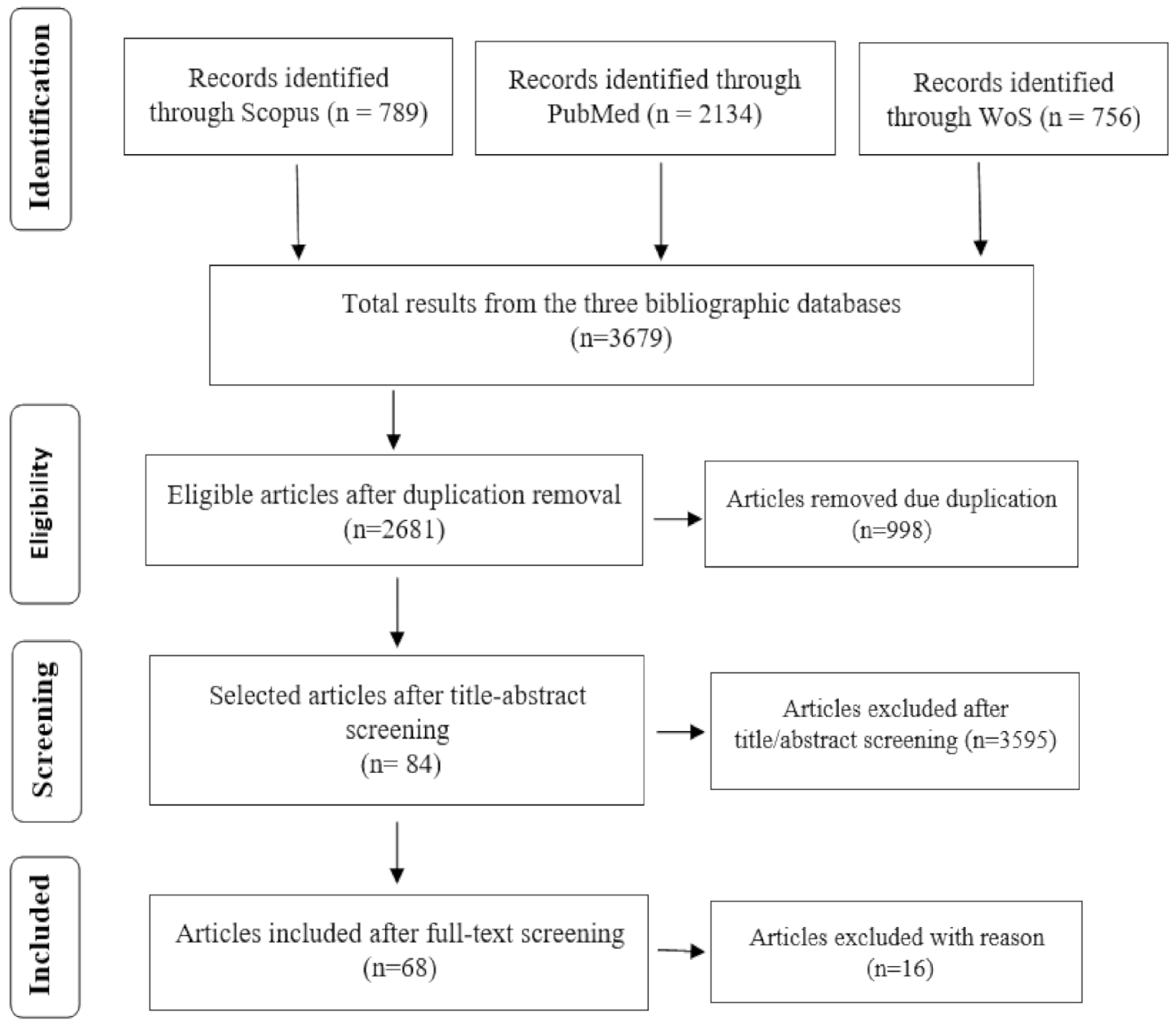
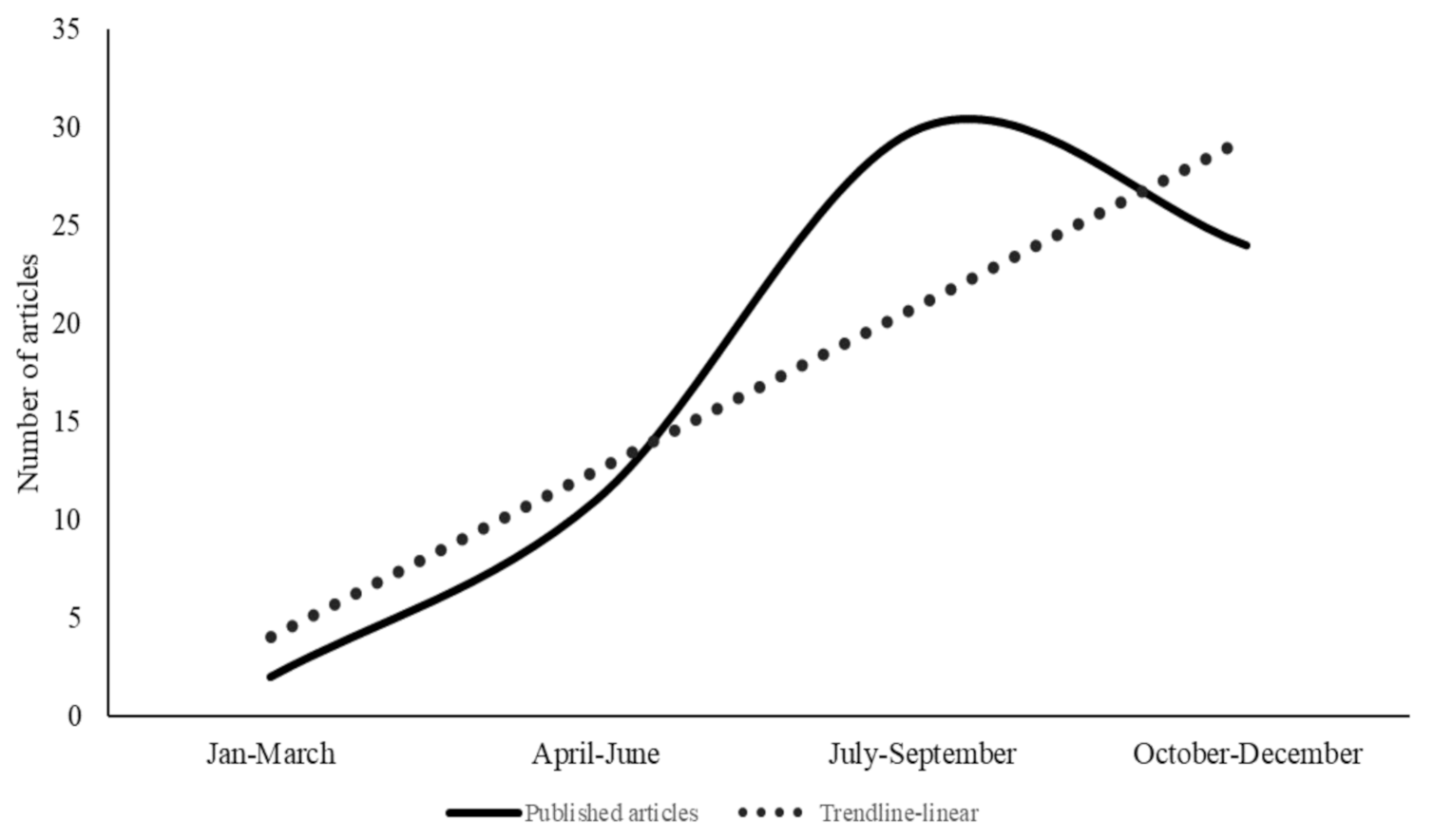
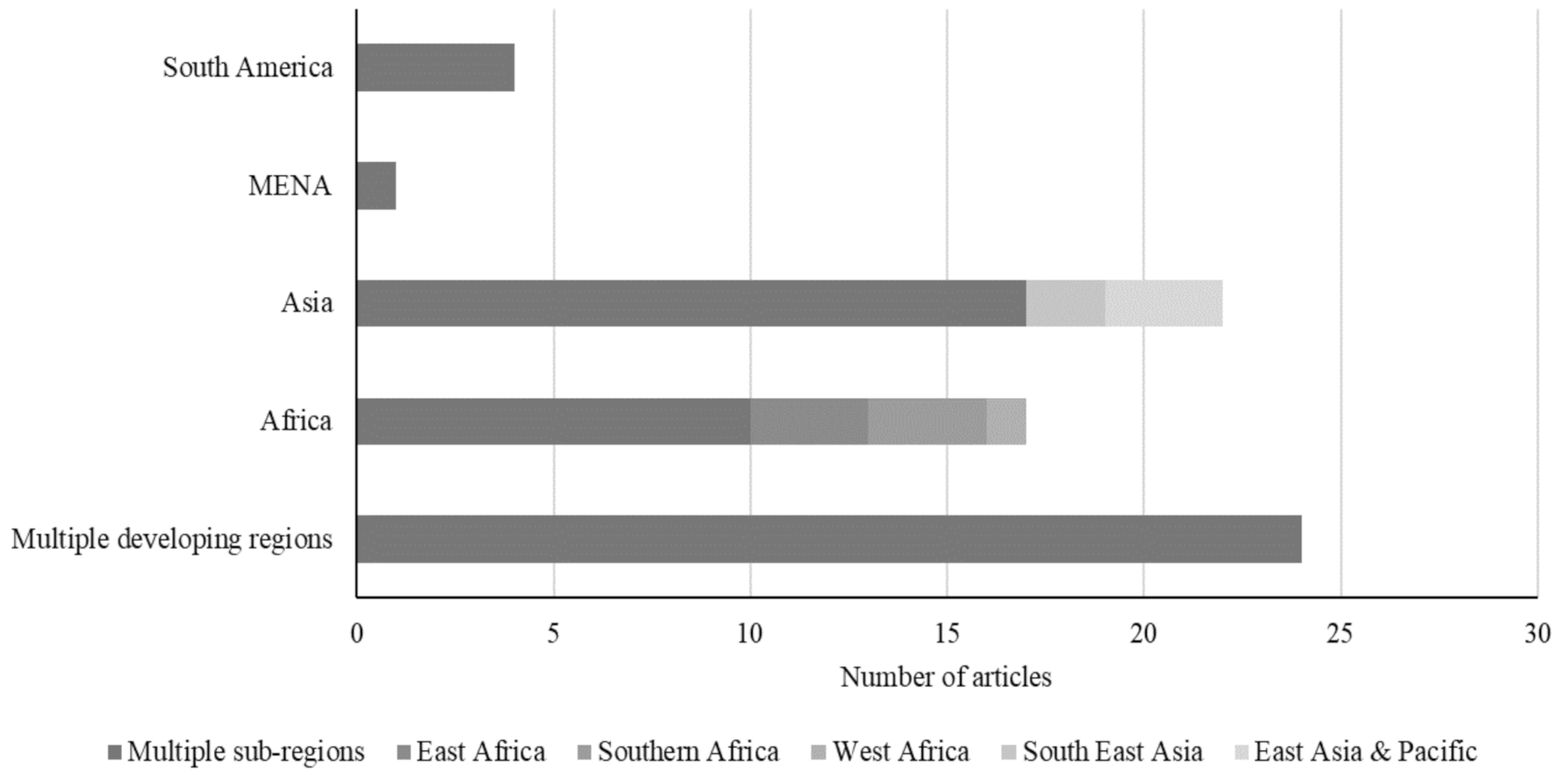

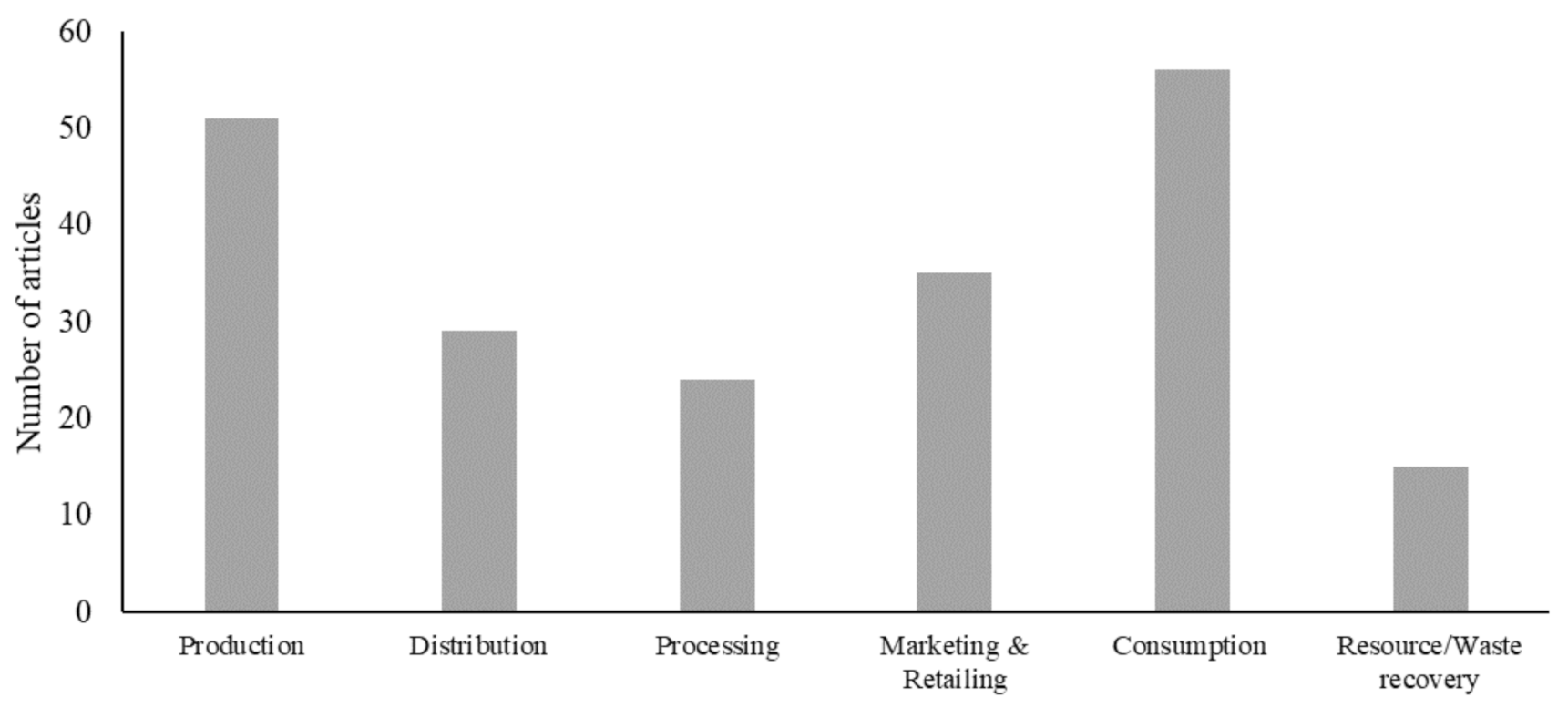
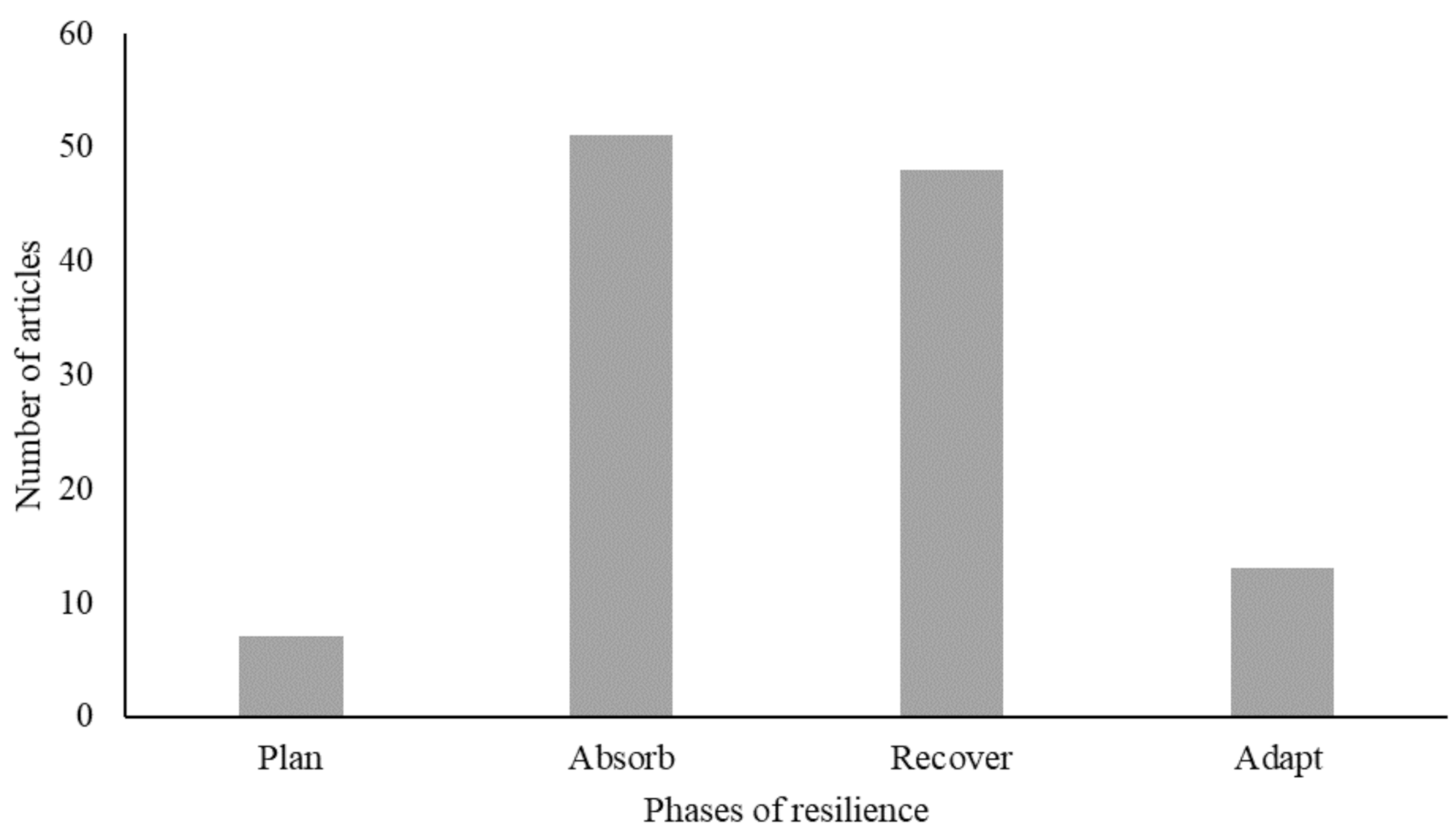
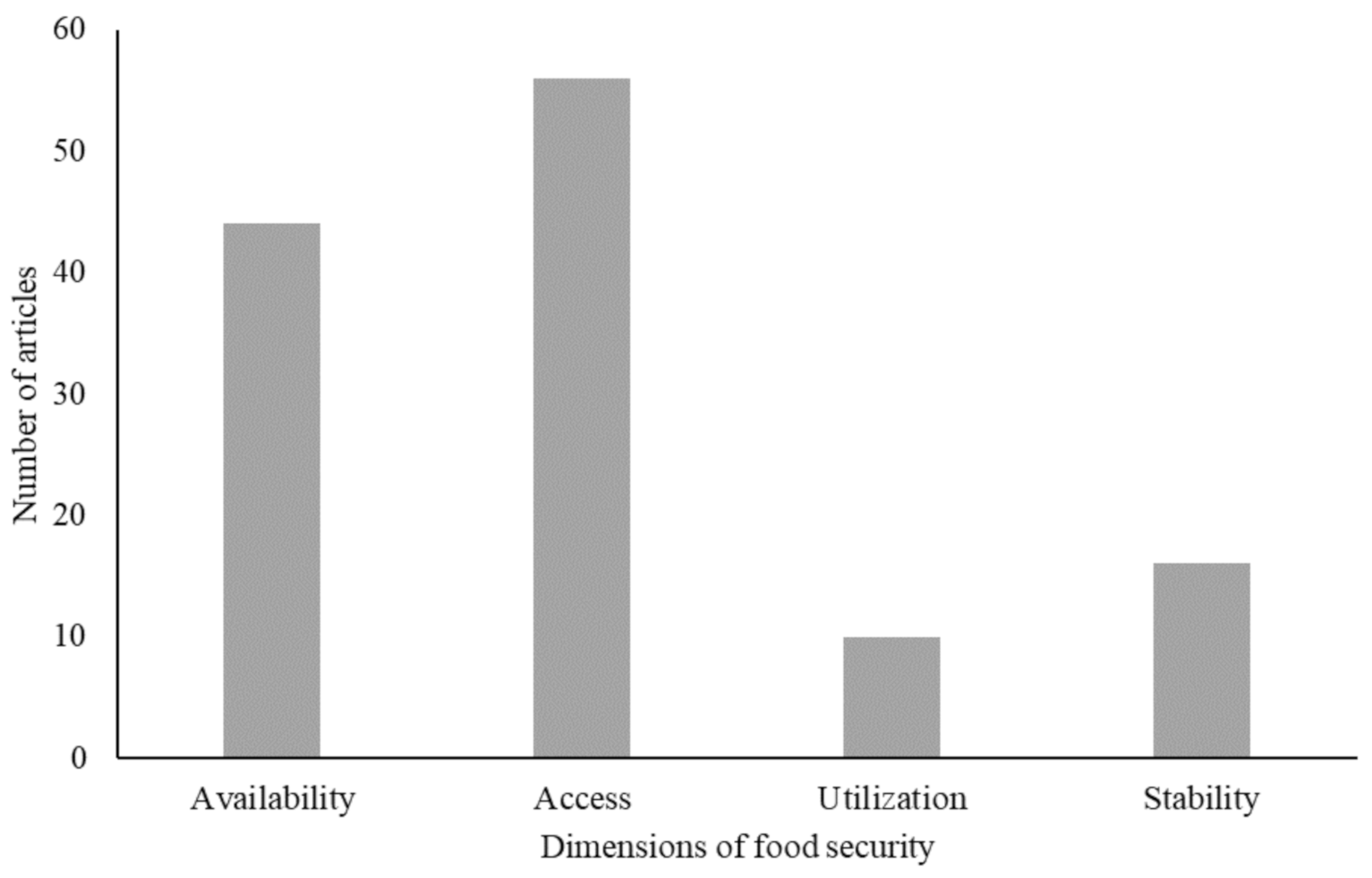
Publisher’s Note: MDPI stays neutral with regard to jurisdictional claims in published maps and institutional affiliations. |
© 2021 by the authors. Licensee MDPI, Basel, Switzerland. This article is an open access article distributed under the terms and conditions of the Creative Commons Attribution (CC BY) license (https://creativecommons.org/licenses/by/4.0/).
Share and Cite
Abu Hatab, A.; Krautscheid, L.; Boqvist, S. COVID-19, Livestock Systems and Food Security in Developing Countries: A Systematic Review of an Emerging Literature. Pathogens 2021, 10, 586. https://doi.org/10.3390/pathogens10050586
Abu Hatab A, Krautscheid L, Boqvist S. COVID-19, Livestock Systems and Food Security in Developing Countries: A Systematic Review of an Emerging Literature. Pathogens. 2021; 10(5):586. https://doi.org/10.3390/pathogens10050586
Chicago/Turabian StyleAbu Hatab, Assem, Lena Krautscheid, and Sofia Boqvist. 2021. "COVID-19, Livestock Systems and Food Security in Developing Countries: A Systematic Review of an Emerging Literature" Pathogens 10, no. 5: 586. https://doi.org/10.3390/pathogens10050586
APA StyleAbu Hatab, A., Krautscheid, L., & Boqvist, S. (2021). COVID-19, Livestock Systems and Food Security in Developing Countries: A Systematic Review of an Emerging Literature. Pathogens, 10(5), 586. https://doi.org/10.3390/pathogens10050586






